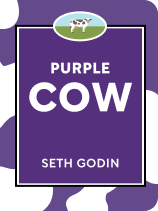

This article is an excerpt from the Shortform book guide to "Purple Cow" by Seth Godin. Shortform has the world's best summaries and analyses of books you should be reading.
Like this article? Sign up for a free trial here .
Are you afraid of taking marketing risks? Do you let your fear of criticism hold you back?
In business, trying to avoid criticism will guarantee failure. If you’re not taking marketing risks to get people’s attention, you’re doomed.
Read more about how overcoming fear and taking marketing risks will pay off.
Take Marketing Risks
You can’t know ahead of time which ideas will work and which will flop. Try them anyway. Playing it safe is almost guaranteed to fail.
The losers in this new world of Purple Cows are the large, old, entrenched corporations. They are unwilling to risk a hit to their bottom line in order to create remarkable products. They grew on the power of the TV-industrial complex and are unwilling or unable to change their strategies now. The corporations (and their shareholders) want to stick with the perceived “safe” methods, and they suffer for it.
The winners are small and mid-sized companies. They have little to lose and a lot to gain by taking marketing risks, so they develop Purple Cows and find success while their larger competitors flounder.
Bovinophobia: Fear of (Purple) Cows
People will give many excuses for why they can’t create—or become—a Purple Cow of their own. They will say that there are no great ideas left; or, there are great ideas out there, but they can’t come up with them; or, they do have a great idea, but their industry or company can’t support it.
These are excuses covering up the real problem, bovinophobia: fear of cows, or in this case, fear of the Purple Cow. People are afraid to stand out, to go against the grain, and to be remarkable. The reason is that remarkable people attract negative attention and criticism, which is something that we’re taught to avoid from a very young age.
In school (at least in the US) kids are organized into classes, sat down in rows, and told to follow the rules. If your behavior doesn’t follow the rules, you’re punished. If your work doesn’t follow the rules, you fail. The best way to get through school is to do as the adults say and not make yourself stand out. Whether intentionally or not, this ingrains the lie that criticism is the same thing as failure, and people fear failure.
Fear creates a logical paradox where it is never the right time to be a risk taker. During bad times, people will be afraid to take risks because they’ll think they can’t risk the financial hit of a failure. However, if you can’t afford to do it right, can you really afford to do it over? On the other hand, during good times people will say there’s no need to take risks. They’ll be afraid to rock the boat and lose what they have.
In business, trying to avoid criticism will guarantee failure. If you’re not taking marketing risks to get people’s attention, you’re doomed. For example, J. Peterman’s clothing catalog is wildly over-the-top: Every piece of clothing is accompanied not by a simple description, but by a whole short story involving the item. The catalog is so weird and silly that it was parodied in Seinfeld—which was great advertising, and led to more profits for Peterman.
Rather than face their fears and take the necessary marketing risks, people look for safety and certainty. They try to eliminate risk from their businesses by playing it safe. As a result, fewer and fewer people try to make Purple Cows.
However, the market is fast-moving and constantly changing. Innovators and early adopters are constantly looking for better products and services. There are so many options these days that people can easily take their business elsewhere, and they frequently do. If you find something wrong with your bank, for instance, there’s sure to be another one just down the street that might be more to your liking.
Therefore, even though fewer people are doing it due to fear, the benefits of creating a Purple Cow are increasing! In exchange for the (perceived) risk of failure or criticism, Purple Cow creators can get huge rewards if their products move through Moore’s idea curve.
The good news about people’s bovinophobia, or fear of Purple Cows, is that every person who’s afraid of failure and criticism makes it easier for you to be remarkable. Every time someone makes another brown cow, it’s a product that your Purple Cow doesn’t have to compete with.
Be a Risk Taker
Interestingly, you can use the same marketing risks principle on yourself. It doesn’t just apply to running your own business; turning yourself into a Purple Cow is one of the best and surest ways to attract attention and find a job.
Don’t play it safe in your career. You can make yourself a Purple Cow by constantly taking on the biggest, most ambitious, and riskiest projects you can find. While succeeding at those projects would obviously be ideal, failing won’t hurt you; even a failure will help get your name out there and associated with high-profile work.
Also, don’t rely on the same boring old resume that everyone else is using; it won’t attract attention. Instead, rely on people who know you to spread the word about how remarkable you are.
“References available upon request” is a quick way to get your resume thrown in the trash with all the others. However, a long list of remarkable references practically demands a face-to-face meeting.
The time to become a Purple Cow is when you’re not looking for a new job. That way, when you do need a new job, you already are the Cow. You’ll be a remarkable employee and the right employer will be thrilled to have you. Being a risk taker pays off.

———End of Preview———
Like what you just read? Read the rest of the world's best book summary and analysis of Seth Godin's "Purple Cow" at Shortform .
Here's what you'll find in our full Purple Cow summary :
- Why you have to be remarkable to succeed
- How to help your business stand out
- How to leverage a single remarkable product for all it's worth






